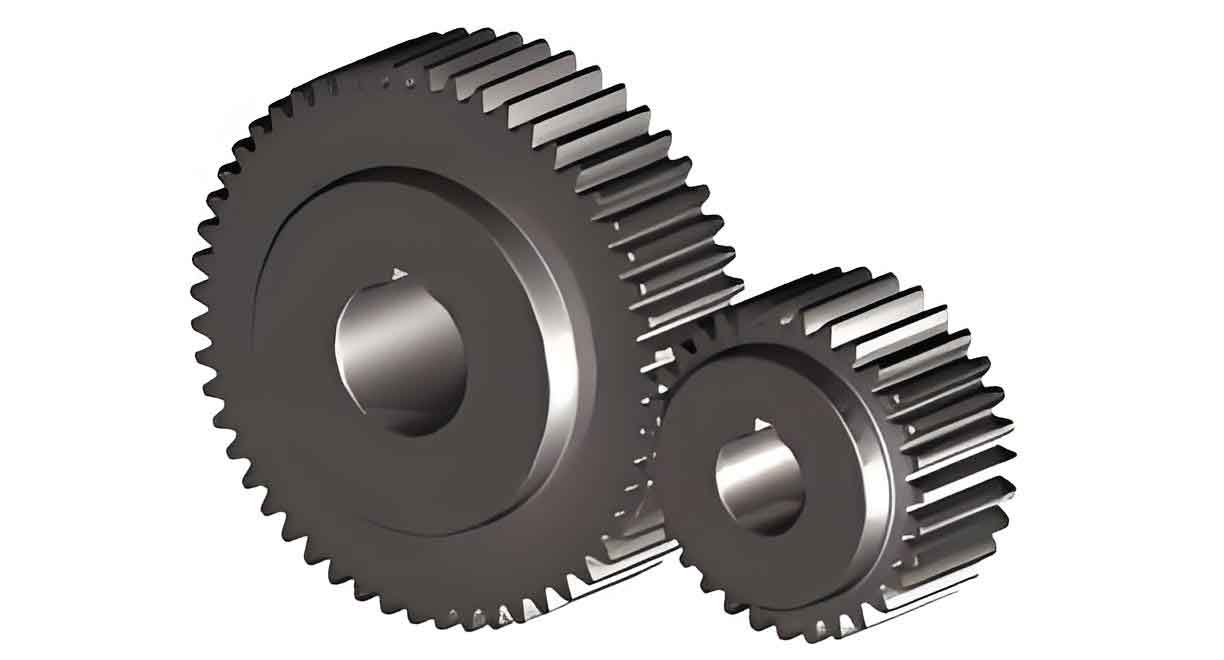Vibration and noise control in spur gear transmission systems remains critical for improving mechanical efficiency and operational longevity. This study presents a novel staggered tooth phase tuning method to suppress gear vibrations by strategically altering meshing stiffness distributions. The method achieves vibration reduction through controlled phase differences between adjacent gear segments while maintaining identical transmission ratios.

1. Fundamental Principles of Staggered Phase Tuning
For a spur gear with face width \( b \), the staggered phase configuration divides it into \( n \) segments with individual phase offsets. The phase relationship between adjacent segments follows:
$$ p = \frac{\phi}{2\pi/z} $$
where \( z \) represents the number of teeth and \( \phi \) denotes the staggered angle. The effective meshing stiffness \( k_d(t) \) for tuned spur gears combines contributions from multiple phased segments:
$$ k_d(t) = \frac{1}{n}\sum_{i=1}^{n} \left[ \bar{k} + \Delta k^{(i)}(t) \right] $$
| Parameter | Segment 1 | Segment 2 | Segment 3 |
|---|---|---|---|
| Face Width (mm) | 13.3 | 13.3 | 13.3 |
| Phase Offset (°) | 0 | 12 | 24 |
| Stagger Ratio | 0 | 0.2 | 0.4 |
2. Meshing Stiffness Modulation
The time-varying meshing stiffness of conventional spur gears follows periodic variation:
$$ k(t) = \bar{k} + \sum_{m=1}^{\infty} \left[ a_m \cos(m\omega_m t) + b_m \sin(m\omega_m t) \right] $$
Phase-tuned spur gears demonstrate modified stiffness characteristics through harmonic superposition:
$$ \Delta k_d = \sum_{m=1}^{\infty} J_m \sin\left(m\omega_m t + \phi_m\right) $$
$$ J_m = 2Q_z |\cos(m\pi p)| $$
$$ Q_z = \frac{2(k_{min}-k_{max})}{m\pi}\sin(m\pi\alpha_1) $$
| Tuning Order | ε=1.506 | ε=1.660 | ε=1.750 |
|---|---|---|---|
| 2nd Order | 84% Reduction | 62% Reduction | 38% Reduction |
| 3rd Order | 71% Reduction | 89% Reduction | 65% Reduction |
| 4th Order | 53% Reduction | 74% Reduction | 92% Reduction |
3. Experimental Validation
A specialized test rig evaluated spur gear performance under various phase tuning configurations:
$$ \text{Vibration Reduction} = \frac{A_0 – A_p}{A_0} \times 100\% $$
| Parameter | Input Side | Output Side |
|---|---|---|
| Natural Frequency (Hz) | 1,250 | 1,180 |
| Sampling Rate (kHz) | 51.2 | 51.2 |
| Load Range (Nm) | 0-140 | 20-100 |
Vibration measurements revealed significant attenuation effects:
$$ \text{RMS Reduction at } p=0.4: \begin{cases}
56.1\% \text{ (Displacement)} \\
38.8\% \text{ (Acceleration)}
\end{cases} $$
4. Dynamic Response Characteristics
The spur gear system’s vibration spectrum shows fundamental frequency components:
$$ f_m = \frac{z n}{60} $$
Phase tuning effectively suppresses meshing frequency harmonics:
$$ H(f) = 20\log_{10}\left(\frac{A_p(f)}{A_0(f)}\right) $$
| Frequency Component | p=0 | p=0.2 | p=0.4 |
|---|---|---|---|
| 1× Meshing Frequency | 0 | -6.7 | -12.4 |
| 2× Meshing Frequency | 0 | -4.9 | -9.8 |
| 3× Meshing Frequency | 0 | -3.2 | -7.1 |
5. Load-Dependent Vibration Behavior
Experimental results demonstrate consistent vibration reduction across operational loads for phase-tuned spur gears:
$$ \frac{dA}{dT} = \begin{cases}
0.034\ \text{m/s}^2/\text{Nm} & (p=0) \\
0.028\ \text{m/s}^2/\text{Nm} & (p=0.2) \\
0.021\ \text{m/s}^2/\text{Nm} & (p=0.4)
\end{cases} $$
The load-vibration relationship maintains linear characteristics while showing reduced sensitivity in tuned configurations.
6. Implementation Considerations
Practical application of staggered phase tuning in spur gears requires:
- Precision manufacturing of phased gear segments
- Spline coupling alignment within ±0.5° tolerance
- Dynamic balancing for high-speed operation
- Thermal expansion compensation strategies
This investigation confirms that staggered tooth phase tuning effectively modulates meshing stiffness characteristics in spur gear systems, achieving substantial vibration reduction through harmonic cancellation. The method demonstrates particular effectiveness in suppressing meshing frequency components while maintaining operational efficiency across varying load conditions.
